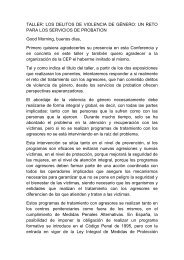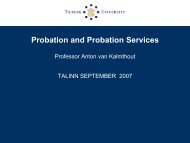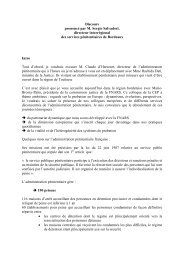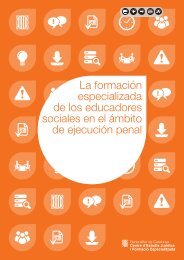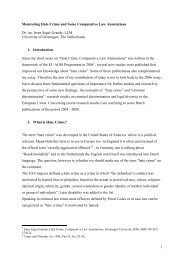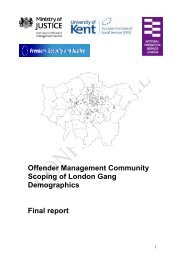What Works in Reducing Reoffending: A Global Perspective
What Works in Reducing Reoffending: A Global Perspective
What Works in Reducing Reoffending: A Global Perspective
Create successful ePaper yourself
Turn your PDF publications into a flip-book with our unique Google optimized e-Paper software.
Offender Rehabilitation:Recent History (1)• Strong rehabilitation optimism <strong>in</strong> the 1960s andearly 1970s• „Noth<strong>in</strong>g works“ (Mart<strong>in</strong>son, 1974)• Lack of methodologically sound research• Support for non-empirical arguments (e.g. gett<strong>in</strong>gtough on crime, high costs, forced personalitychange, <strong>in</strong>formalisation of crim<strong>in</strong>al justice, justdeserts punishment)• Revitalisation of rehabilitation <strong>in</strong> the 1990s• Better theoretical foundation• More longitud<strong>in</strong>al research on desistance
Recent History (2)• More controlled evaluations• Systematic research reviews (meta-analyses)• More <strong>in</strong>ternational exchange• „<strong>What</strong> works“ <strong>in</strong>stead of „noth<strong>in</strong>g works“• Programme accreditation & qualitymanagement (e.g., Canada, England & Wales,Netherlands, Scotland, Sweden)• Large-scale implementation of offend<strong>in</strong>gbehaviour programmes
England & Wales: National Offender ManagementService (NOMS): Pathways to Reduc<strong>in</strong>gRe-offend<strong>in</strong>g (2006)
Attitudes, Th<strong>in</strong>k<strong>in</strong>g & BehaviourProgrammes• Social learn<strong>in</strong>g theories• Re<strong>in</strong>forcement & model<strong>in</strong>g• Social <strong>in</strong>formation process<strong>in</strong>g &problem solv<strong>in</strong>g• Social <strong>in</strong>tegration & bond<strong>in</strong>g• Action theory• Theries of moral attitudes & beliefs• Neuropsychological theories
Evidence comes by replication• More than 700 more or less well controlledevaluations of correctional treatmentworldwide• Majority from North America• For nearly all programmes: positive vs. zeroor sometimes even negative effects• Many factors are relevant: Methodology,samples, context, culture, staff motivation,implementation a.s.f.• No sound conclusions from one s<strong>in</strong>gle study• Systematic reviews/meta-analyses of goodquality primary studies
Study Quality: Maryland Scale(Sherman et al., 1997, modified)1. No control/comparison group (CG)2. Nonequivalent CG (e.g., refusers)3. CG judged to be equivalent (e.g.,comparison of offender characteristics)4. Systematic strategy applied to achieveequivalence (e.g., match<strong>in</strong>g)5. Randomized assignment (not impairedby attrition etc.)
Mean Effect Sizes (d) <strong>in</strong> Meta-Analyses onGeneral Offender TreatmentLipsey & Landenberger (2005)In total >500 studiesTong & Farr<strong>in</strong>gton (2007)MacKenzie (2006)Lipton et al. (2002)Lipton et al (2002)Dowden & Andrews (2000)Redondo et al. (1999)Pearson et al. (1998)Lipsey & Wilson (1998)Lipsey (1992)Andrews et al. (1990)Gottschalk et al. (1987)Lösel et al. (1987)0,00 0,05 0,10 0,15 0,20 0,25 0,30
Mean Effect Sizes (d) <strong>in</strong> Meta-Analyses onJuvenile Offender TreatmentLatimer et al. (2003)Cleland et al. (1997)Redondo et al. (1999)Petros<strong>in</strong>o (1997)Lipsey & Wilson (1998)Lipsey (1992)Andrews et al. (1990)Whitehead & Lab (1989)Gottschalk et al. (1987)Garrett (1985)0,00 0,10 0,20 0,30 0,40
Mean Effect Sizes (d) <strong>in</strong> Meta-Analyses onSexual Offender Treatmentd0,60,50,40,30,20,10Alexander (1999)Aos et al. (2006)Furby et al. (1989)Gallagher et al. (2000)Hall (1995)Hanson et al. (2002)Lösel (2000)Lösel & Schmucker (2005)Polizzi et al. (1999)Reitzel & Carbonell (2006)Walker et al. (2004)
Meta-Analysis of High-quality Studieson Sex Offender Treatment• Schmucker & Lösel (2010): Update ofLösel & Schmucker (2005)• Only high-quality studies• Level 3 of Maryland Scale• Treatment & Control Group equivalent• 26 eligible studies, 28 <strong>in</strong>dependentcomparisons between TG and CG• N = 8,347 offenders (3,919 treated)• Ma<strong>in</strong>ly Cognitive-behavioural programmes(n = 20)
Recidivism Rates(Length of follow up: M = 5.7 years)%50,040,0Treatment groupControl group26% reduction32,430,027% reduction24,020,012,410,09,00,0sexualall offencesType of reoffend<strong>in</strong>g
Some Outcome ModeratorsLarger effects <strong>in</strong>• smaller samples• high risk offenders• group programmes with some<strong>in</strong>dividual sessions• better descriptive validity
Mean Effect Sizes of OffenderRehabilitation (2)• In total ca. 10% - 30% reduction <strong>in</strong> reoffend<strong>in</strong>g• Statistically and practically significant• Benefit-cost ratios: 1 – 7 € payoff for each €<strong>in</strong>vested• Lifetime costs for 1 persistent offender ca. 1 M• Effect sizes <strong>in</strong> medic<strong>in</strong>e:• Radiation + chemotherapy of bra<strong>in</strong> tumors: ca.10%• Aspir<strong>in</strong> therapy of cardiovascular events: ca. 13%• Passive smok<strong>in</strong>g and lung cancer: ca. 22%• Drug treatment of depression: ca. 56%
Variation <strong>in</strong> Outcome BetweenOffender Rehabilitation Programmes• Previous figures: overall means• Differences between various programmes &even between studies on one and the sameprogramme• No s<strong>in</strong>gle „magic bullet“ or „gold standard“programme• Programme content is only one reason foroutcome differences• Many other factors play a role• They expla<strong>in</strong> more variance than programmecontent• ‚<strong>What</strong> works‘ question often too simple
<strong>What</strong> works:Relatively consistent positive effects• Basic education (e.g. literacy, maths)• Vocational & employability programmes (if useful<strong>in</strong> life)• Cognitive-behavioural programmes (CBT; e.g.,Reason<strong>in</strong>g & Rehabilitation, Cogn. Restructur<strong>in</strong>g,Moral Reconation Therapy, Anger Management)• Most important elements <strong>in</strong> CBT: Angermanagement & <strong>in</strong>terpersonal problem solv<strong>in</strong>g• Structured therapeutic communities (TCs), milieutherapy & Social-therapeutic prisons (Germany)
<strong>What</strong> works:Relatively consistent positive effects• Multisystemic Therapy (MST) and othermultimodal family-oriented programmes foryoung offenders• Restorative Justice (e.g., offender-victimmediation, restitution; not for all groups)• Drug courts• sychopharmacological/substitution drugtreatment
Promis<strong>in</strong>g: Not yet well-replicatedand/or rather small effects• Intensive supervision (probation, parole)• Electronic monitor<strong>in</strong>g (problem of IS & EM:revocation, violation of orders)• Counsel<strong>in</strong>g (juveniles & adults)• Mentor<strong>in</strong>g programmes• Challenge programmes• Social case work• Pharmacological treatment for aggressiveimpulsiveoffenders (SRIs) and sexual offenders(hormonal treatment)
<strong>What</strong> doesn‘t work:Mean zero or even negative effetcs• Pure sanction (e.g. custodial vs. non-custodialsentences, longer prison sentences, regularsanction vs. diversion)• Purely deterrent measures (e.g. ScaredStraight, shock <strong>in</strong>carceration for juveniles)• Strict discipl<strong>in</strong>e (e.g. Boot Camps, whenwithout treatment elements)• Purely psychodynamic and unstructuredtherapeutic approaches• Inappropriate programmes may even harm
The Good Lives Model (Ward, 2002):N<strong>in</strong>e Goods• Life (<strong>in</strong>clud<strong>in</strong>g healthy liv<strong>in</strong>g and function<strong>in</strong>g)• Knowledge• Excellence <strong>in</strong> work and play• Excellence <strong>in</strong> agency (autonomy, self-directedness)• Inner peace (freedom from emotional turmoil, stress)• Friendship and community (<strong>in</strong>timate partner, familyrelations)• Spirituality (f<strong>in</strong>d<strong>in</strong>g mean<strong>in</strong>g and purpose <strong>in</strong> life)• Happ<strong>in</strong>ess• Creativity
Evaluation of the Good Lives Model• Increas<strong>in</strong>gly popular <strong>in</strong> practice• Strength-oriented (as is MST)• Relations to humanistic psychotherapy,positive psychology & resilience research• Some <strong>in</strong>direct support from desistanceresearch• But: Not yet replicated empirical evidence <strong>in</strong>evaluations• Conclusion: Perhaps promis<strong>in</strong>g
Pr<strong>in</strong>ciples of Appropriate Offender• Risk pr<strong>in</strong>ciple(Adequate <strong>in</strong>tensity)Treatment• Need pr<strong>in</strong>ciple(Address crim<strong>in</strong>ogenic needs)• Responsivity pr<strong>in</strong>ciple(Adequate modes of learn<strong>in</strong>g and teach<strong>in</strong>g)• Up to 60% reduction of recidivism when all three R-N-Rpr<strong>in</strong>ciples realized• Smaller effect when 2 or 1 pr<strong>in</strong>ciple present; slightlynegative effect when no R-N-R pr<strong>in</strong>ciple addressed• Problems of R-N-R approach: Some circularity re.responsivity; risk not <strong>in</strong>dividualizedAndrews et al. (1990)
Transfer of ‚<strong>What</strong> <strong>Works</strong>‘ Pr<strong>in</strong>ciples<strong>in</strong>to Policy & Practice• Best example: England & Wales• Ambitious political aims <strong>in</strong> the 1990s and 2000s:5% & 10% reduction of reoffend<strong>in</strong>g• Systematic programme development, accreditation& implementation• Intensive <strong>in</strong>vestment of Home Office/M<strong>in</strong>istry ofJustice• Coord<strong>in</strong>ated action: NOMS, HMPS, NPD, CSAP• More than 40 accreditated programmes• Quality management (assessment, staff tra<strong>in</strong><strong>in</strong>g &supervision, monitor<strong>in</strong>g & audit, outcomeevaluation)
Criteria of the Correctional ServicesAccreditation Panel (CSAP) <strong>in</strong> E & W1. Clear model of change (evidence based)2. Selection of offenders (e.g., adequateassessment, risk level)3. Target<strong>in</strong>g a range of dynamic risk factors4. Effective methods (i.e., cognitivebehavioural)5. Skills orientation (concrete behaviour)
CSAP Accreditation Criteria(Cont<strong>in</strong>ued)6. Sequenc<strong>in</strong>g, <strong>in</strong>tensity and duration7. Engagement and motivation8. Cont<strong>in</strong>uity of programme and services(aftercare; community services)9. Ma<strong>in</strong>ta<strong>in</strong><strong>in</strong>g <strong>in</strong>tegrity (context; selection,tra<strong>in</strong><strong>in</strong>g, and supervision of personnel)10. Ongo<strong>in</strong>g evaluationBased on pr<strong>in</strong>ciples of effective <strong>in</strong>tervention: Andrews (1995), Lösel (1995)
Accredited Programmes <strong>in</strong> E & W (2)Some encourag<strong>in</strong>g results (Harper & Chitti,2005):• Well-implemented cognitive-behaviouralprogrammes for medium to high risk offenders• Aggression replacement tra<strong>in</strong><strong>in</strong>g <strong>in</strong> probation• Sex offender treatment programmes• Drug treatment programmes• Motor<strong>in</strong>g offence programmes• Programmes <strong>in</strong>clud<strong>in</strong>g family relations <strong>in</strong>treatment and aftercareHarper & Chitti (2005)• However, methodologically weaker datasuggest some success of the treatment policy
Adult Re-offend<strong>in</strong>g Rates <strong>in</strong> E & WPercentage of offenders committ<strong>in</strong>g at least one offence with<strong>in</strong> one yearof discharge from prison or commencement of probation supervision50452000-06: - 11%40353025202000 2002 2003 2004 2005 2006Note. No valid data available for 2001 MoJ Evidence Digest (2009)
Adult Re-offend<strong>in</strong>g Rates <strong>in</strong> E & WNumber of offences per 100 offenders with<strong>in</strong> one year of discharge fromprison or commencement of a court order under probation supervision2302101901701501301109070502000-06: - 23%2000 2002 2003 2004 2005 2006Note. No valid data available for 2001 MoJ Evidence Digest (2009)
Re-Offend<strong>in</strong>g Rates of Prisoners bySentence Length (HMPS 2007)807060504030200020022003200420< 1 year ≥ 1 & < 2years≥ 2 & < 4years≥ 4 yearsDiff. actual/ - .02% - 6.3% - 10.1% - 13.4% Total: - 3.1%predicted
Re-offend<strong>in</strong>g rates for offend<strong>in</strong>g behaviourprogrammesPredicted ratesActual rates%75706560555045403530Non-starters Starters / Dropouts CompletersDiff = 7.3% Diff = 4.8% Diff = 26.4%
Interim Accredited Programmes Software:2004 Community Cohort (Hollis, RDS NOMS, 2007)Reduction <strong>in</strong> Re-Offend<strong>in</strong>g Us<strong>in</strong>g Predicted DataTotal (n = 25,255)Dr<strong>in</strong>k impaired drivers (1,148)General offend. behav. (12,924)Domestic violence (1,148)***Sex offender progr. (741)Substance misuse (5,081)Anger management (1,148)Women's programme (62)***0 5 10 15 20 25 30 35 40
Conclusions for <strong>in</strong>ternationalpractice• In total positive results of correctionalprogrammes• However, most ‚what works‘ research fromNorth America• Experience <strong>in</strong> Europe: Local adaptation andevaluation necessary• Very few controlled studies <strong>in</strong> non-Englishspeak<strong>in</strong>gcountries• Problems of transfer from/to other countries• Remember: Many factors determ<strong>in</strong>e outcome
Factors that have an impact on outome<strong>in</strong> meta-analyses: Examples (1)• Programme content/type (++)• Content of the control condition (+)• Quality of evaluation design (?)• Length of follow up (-)• ‚Hard‘/official outcome measures (-)• Small vs. large samples (++)• High vs. low risk offenders (++)• Juvenile vs. adult offenders (+)
Factors that have an impact beyondprogramme content: Examples (2)• Many dropouts, counted as treated (--)• Voluntary vs. mandatory treatment (?)• Integrity of programme implementation (+)• Staff tra<strong>in</strong><strong>in</strong>g & supervision (+)• Staff-prisoner relations/social climate (+)• Demonstration project vs. rout<strong>in</strong>e practice (+)• Researchers <strong>in</strong>volved <strong>in</strong> programmedevelopment/delivery (+)• Community vs. custody (+)
Problems of transnational transfer• Different cultural traditions• Different justice systems• Different age ranges for juveniles• Different m<strong>in</strong>ority problems• Different organizational structures ofprison & probation• Different staff roles
Problems of transnational transfer• Different experiences <strong>in</strong> evaluation• Differences <strong>in</strong> f<strong>in</strong>ancial resources• Different weight<strong>in</strong>g of various penalaims: compensation of guilt,protection of the public, generaldeterrence, rehabilitation, restitution• Differences <strong>in</strong> crime policy• Differences <strong>in</strong> <strong>in</strong>carceration rates
Incarceration Rates
Incarceration Rates <strong>in</strong> EuropePer 100,000 population <strong>in</strong> 200-08 ( Walmsley, 2009)Russia 629Belarus 468Georgia 415Ukra<strong>in</strong>e 323Latvia 288Estonia 259Lithuania 234Poland 221Czech Republic 182Spa<strong>in</strong> 160England & Wales 153Scotland 152Hungary 149Slovakia 148Bulgaria 134Romania 124Serbia 122Greece 109
Incarceration Rates <strong>in</strong> EuropePer 100,000 population <strong>in</strong> 200-08 ( Walmsley, 2009)Netherlands 100France 96Austria 95Croatia 93Italy 92Belgium 93Germany 89Northern Ireland 88Switzerland 76Sweden 74Norway 69Slovenia 65Denmark 63F<strong>in</strong>land 64Iceland 44Liechtenste<strong>in</strong> 22
: England & Wales
Incarceration rates• S<strong>in</strong>ce the 1990s <strong>in</strong>crease <strong>in</strong> many countries• Not clearly related to crime rates• Political decisions• Recently decrease <strong>in</strong> several countries• Incarceration very costly• Lack of resources for effective treatmentand prevention? (e.g. California)• Reduction by effective offender treatment& less short-term imprisonment• The chance of ‚older‘ populations
Conclusions and <strong>Perspective</strong>s (1)• <strong>Global</strong> f<strong>in</strong>d<strong>in</strong>gs on rehabilitationprogrammes positive• Cont<strong>in</strong>uity & stepwise improvement <strong>in</strong>steadof pendulum movements <strong>in</strong> policy• Cultural adaptation & differentiation• Quality management, process & outcomeevaluation• Centers of excellence, clear<strong>in</strong>g houses• Knowledge transfer and management of<strong>in</strong>novation
Conclusions & <strong>Perspective</strong>s (2)• Integrat<strong>in</strong>g correctional programmeswith the whole range of services (no„silo“ approach)• L<strong>in</strong>kage to rout<strong>in</strong>e case work• Relations to natural processes ofdesistance• Relations to developmental prevention• Crime not only a crim<strong>in</strong>al justice issue(e.g. public health, education, welfare& economy)
Contact:starr@crim.cam.ac.ukfal23@cam.ac.uk


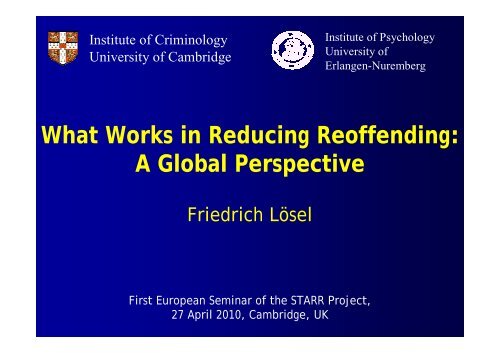
![AGIS2 Nov 08 Conference Report_[Version 2] - CEP, the European ...](https://img.yumpu.com/50764570/1/190x245/agis2-nov-08-conference-report-version-2-cep-the-european-.jpg?quality=85)

